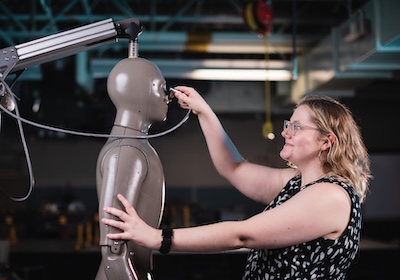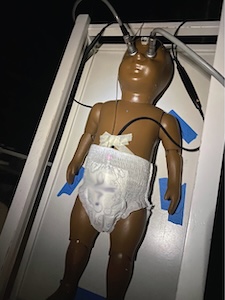The CMDT contributes to Global Innovation Award for wool-core diapers
The Center for Merchandising and Design Technology conducts thermal comfort and moisture dispersion testing on diapers for New Zealand-based company, Woolchemy.
Woolchemy, a New Zealand-based company that focuses on high performance and sustainability using natural wool fibers, was honored with the Raw Material Achievement Award at IDEA25, the leading global nonwovens conference. The Center for Merchandising and Design Technology (CMDT) was able to partner with Woolchemy by both providing the lab space and conducting thermal comfort and moisture dispersion testing. With their findings, Woolchemy was recognized for their innovation in developing the world’s first hygiene-grade wool, newFibre, to power high-performance wool-based materials like newFlex ADL for use in diapers, feminine care, and other disposable hygiene products.
The CMDT is a research and design facility housed in the Engineering and Technology Building that provides solutions to apparel and textile design problems using an innovative and multidisciplinary approach. Known for its cutting-edge equipment, textile testing, prototype development and evaluation, and wearer trial and fit analysis, the reach of the CMDT goes far beyond the classroom. Industry collaborators include Carhartt, Lululemon Athletica, and Ford, just to name a few.

Woolchemy approached the CMDT looking to compare their wool-core diapers, created from newFibre, with traditional synthetic core diapers that are currently on the market. According to Lauren Agnew, Laboratory Coordinator for the CMDT, there is currently no standard methodology for diaper testing. “It’s wild to me that something so close to a vulnerable population has so little 3D-based testing to verify its capabilities,” says Agnew. Testing was conducted by CMDT students and staff using Lumi, a state-of-the-art infant thermal manikin—one of only four in the entire world located at a public research institute and the only one in North America! Lumi is approximately the size of a 12-month-old child and is constructed from a thermally conductive carbon-epoxy shell with inside heating elements and temperature sensors. All testing with Lumi must occur within an environmental chamber within the CMDT Lab that can control heat and humidity while keeping air velocity at a minimum.
The proprietary method used to conduct testing on Lumi allowed the CMDT to see the spread of moisture while the infant is lying down, similar to a sleeping baby. Agnew states it took the CMDT multiple years to develop this method to ensure diaper testing was reliable and consistent, something the center is very proud of. The data collected showed that the Woolchemy diaper was more stable and consistent in keeping the infant’s microclimate dry compared to the synthetic core of the current on-the-market diaper, resulting in a more thermally comfortable environment.

This achievement is a big step towards a more sustainable future when it comes to diapers and other disposable hygiene products. Traditional diapers are made of a petroleum core (plastic, synthetic material), which will take hundreds of thousands of years to decompose, if ever. “Thinking about how many diapers parents use in a baby's first few years of life, the environmental impact is immense,” says Agnew. “Woolchemy's innovative core is hopefully just the start, and I hope that other diaper developers begin exploring alternative, sustainable, biodegradable materials.” Woolchemy hopes to continue research and innovation to create high-performing, sustainable materials that deliver comfort, skin compatibility, and meaningful impact to brands and consumers.
This research wouldn’t be possible without the help and dedication of the CMDT team. Strict testing methodology required students who work in the lab to be extremely attentive and detail oriented. Agnew adds, “I am so immensely proud of the work my students have done in regard to this project.” Congratulations to the CMDT on this fantastic achievement!




